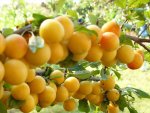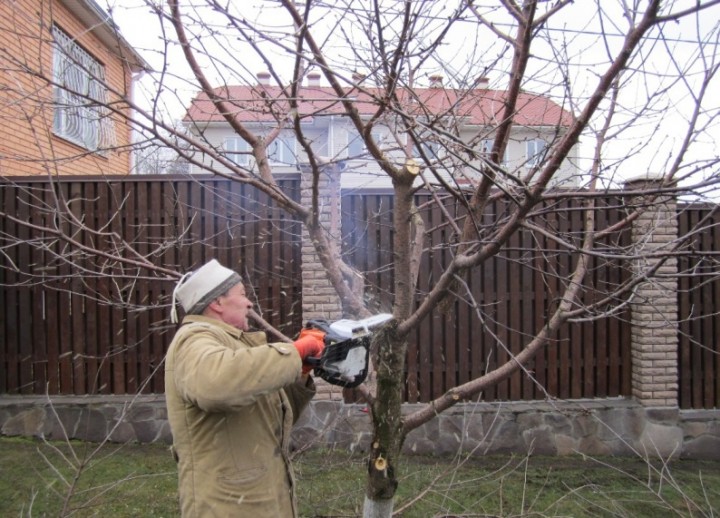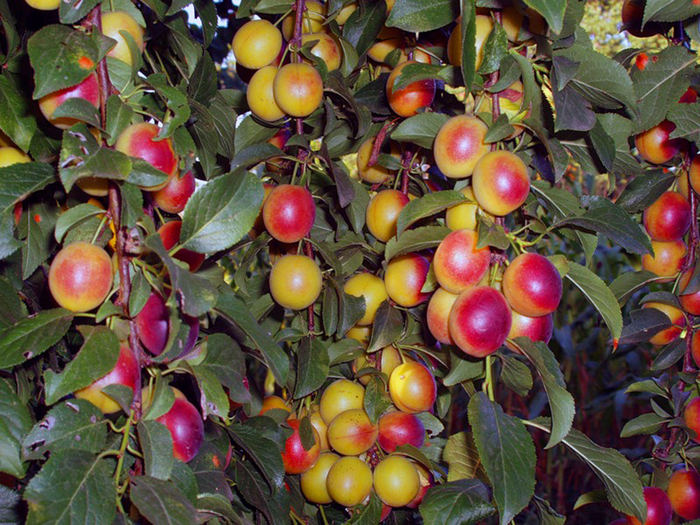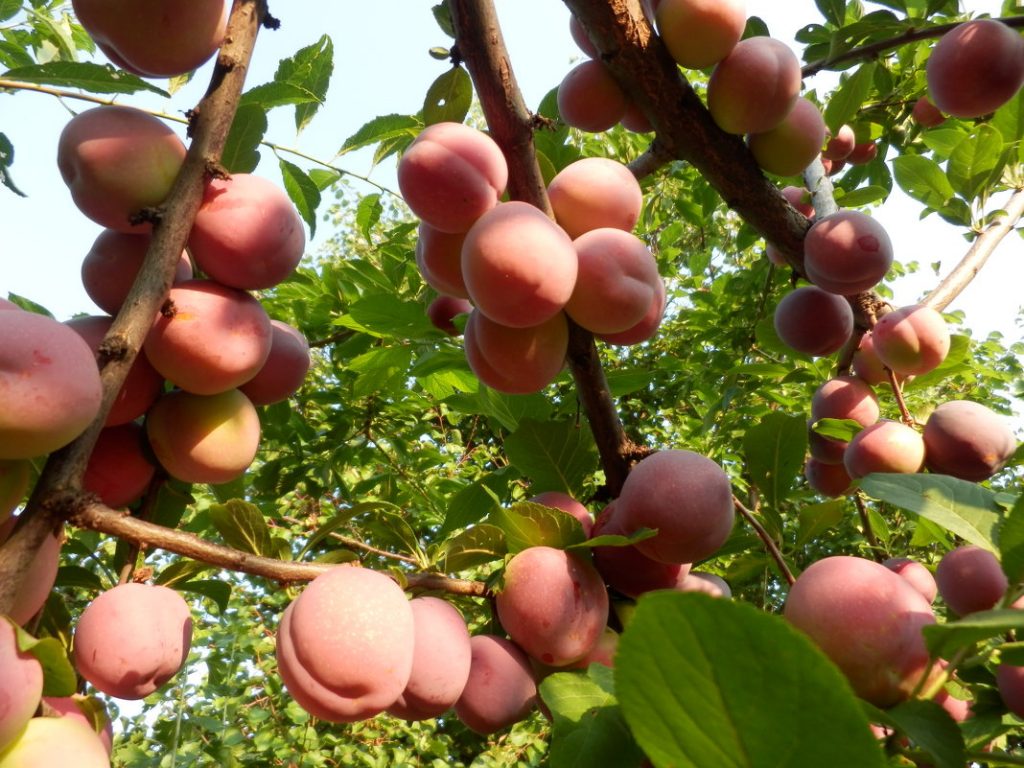Cherry plum pruning - how to get a beautiful crown and a decent harvest
Content
Pruning features
This culture has tree, bush and hybrid varieties. All of them require pruning, but for each species it is necessary to form the crown in a different way, since they have different strength and growth rates of the shoots, and the fruits are formed on peripheral or main shoots of different ages. This individual approach to the process of pruning cherry plum differs from other fruit crops.
Cherry plum is not only pruned to form the crown. Proper pruning should regulate the quantity of fruit and even influence its quality. If you know how to properly prune a tree, you can save it from many diseases, rejuvenate it, and continue the fruiting period. Therefore, before cutting the cherry plum, you need to know exactly the goals and the best timing for this important agrotechnical event.
Most gardeners believe that the main pruning should be done in early spring, while the buds have not yet blossomed. This is the time when pruning is most painless for the plant. In summer, the tree actively grows, accumulates in its leaves the nutrients it needs for life. Pruning shoots in the summer causes painful wounds and deprives the tree of these accumulated reserves for the future. Therefore, pruning only if it cannot be postponed until autumn. The reason may be a disease, when it is necessary to urgently remove the affected parts, or a branch growing in the middle of the crown, which will still have to be removed, it is better to do this as soon as possible so that it does not draw off the forces of the plant.
In autumn, sanitary pruning is carried out, dry, damaged, diseased branches are removed, which can become a breeding ground for pests or diseases. Harvesting non-fruiting branches that direct their growth downward, go down to the ground. But there are varieties of cherry plum, the main pruning of which is recommended to be carried out in the fall or at the end of summer, for example, "Kubanskaya Kometa".  In winter, pruning is not done - the branches that are fragile and brittle due to the effects of frost then heal for a long time, and it would be difficult to follow the pruning scheme with such a material.
In winter, pruning is not done - the branches that are fragile and brittle due to the effects of frost then heal for a long time, and it would be difficult to follow the pruning scheme with such a material.
Cropping Video
From the video you will learn how to properly crop.
Pruning a young plant
As soon as the seedling has been planted in its permanent place, the correct crown is formed at the cherry plum, in three to four years the skeleton of the tree is usually created. Most often, trees and bushes are given a bowl-shaped shape so that sunlight penetrates the center of the tree without hindrance, and the branches do not block neighbors from it, their interlacing and too dense growth should not be allowed. This shape assumes that there is no central conductor at all, and the skeletal branches are directed in different directions from the trunk, forming a wide crown bowl. The conductor is present only in the columnar cherry plum.
In some varieties, the central conductor itself deviates to the side, so that it does not have to be cut out, and it simply will not work to form a pyramidal crown. Sometimes, immediately after planting (first - second year), a couple of branches can be distinguished, from which skeletal branches of the first tier will be formed.
They are cut 50 cm so that branches of the second order are formed on them. If those shoots that should become the main ones are shorter than 50 cm, then they are cut off by a third of the length, and the rest of the pruning is transferred to the next year, the branches of the second order are formed later.
When creating a flattened crown (like a sparse-tiered, vase-shaped), the second branch, located above the first, is shortened at the same level as it, and the shortening of the central conductor should be at least 30 cm. The next pair of skeletal branches is formed from the third year after planting.
Many varieties of cherry plum are distinguished by the rapid growth of branches and the formation of a large number of shoots already at a young age, so they have to be thinned out. Strong semi-skeletal branches are left at a distance of 20 cm from each other on the trunk and main branches. Excess branches thickening the crown must be removed immediately, otherwise, when removed after a year, tops will begin to form around the cut, which also must be immediately removed, thereby increasing the number and size of wounds on the tree.
All sections must be treated with garden varnish for better wound healing, as well as in order to prevent the occurrence of infections.
Pruning an adult plant
For an adult plant, sanitary pruning of branches is mandatory. It is necessary to remove or shorten the damaged, dried out branches growing contrary to the conceived pattern of the crown. Cut out shoots that cover their neighbors, rub against other branches, grow inside the crown or vertically downward.
Formed at a young age, the crown should have 4 - 5 skeletal branches with many shoots growing in the right direction. It is necessary to ensure that the distance between the tiers remains at the level of 45 cm, the main shoots are shortened by a third, and the side branches - up to 5 or 7 buds.
Anti-aging pruning is performed every 5 to 6 years. The older the tree, the more its branches are shortened. All work is carried out with a sharp instrument, which must be disinfected before and after work. Each cut must be treated with garden varnish or at least with oil paint.
Reaching 5 - 6 years of age, cherry plum begins to bring large yields, and the growth of branches decreases. If we allow shading of the central part, then the formation of fruits will move to the sides, to the periphery. Therefore, you need to monitor the growth of shoots all the time and prevent thickening of the central part of the crown.
Pruning a mature cherry plum tree or bush is mainly aimed at regulating the production of fruits, the quantity and quality of the crop.  The condition of the plant after wintering suggests how much the branches need to be shortened so that the number of fruits does not impair their quality (after a good wintering). On the contrary, if after winter half of the fruit buds froze, then the adult tree is cut off strongly, and the young, but already formed, is shortened less.
The condition of the plant after wintering suggests how much the branches need to be shortened so that the number of fruits does not impair their quality (after a good wintering). On the contrary, if after winter half of the fruit buds froze, then the adult tree is cut off strongly, and the young, but already formed, is shortened less.
Features of pruning of different varieties
Treelike cherry plum has tall varieties, reaching 8 - 9 meters ("Beauty", "Iona", "Kulturnaya zheltaya"), medium-sized, growing up to 7 meters ("Zelenka early", "Kulturnaya krasnaya"), low-growing - up to 4 - 5 meters ("Ashtarak" and its hybrids). All of them form fruits on 8 - 9-year-old overgrown shoots.
Bushy cherry plum bears fruit on annual branches, on 1 - 2-year-old fruit wood, and after 3 - 4 years fruiting is transferred to the sides if pruning is done incorrectly. The bushy cherry plum gives much more shoots than the tree-like one, its crown thickens rather, although its varieties differ in the length of the shoots. Common varieties: "Lyusha", "Beauty", "Pionerka", "Purple".
The varieties of the hybrid group ("Pobeda", "Strawberry", "Kubanskaya Kometa") do not differ in strong growth, the shape of the crown is flat-round, since the central conductor itself is "lost", that is, it moves aside at a young age. Fruits are formed on one-year growth and on 1 - 2-year-old bouquet branches.
It is on the basis of such different abilities for fruit formation, growth rate and the emergence of new shoots, they carry out pruning of cherry plum of different varieties.
If the crown of the tree is columnar, then you need to remove the shoots that form on the central conductor in time. In hybrid cherry plum, its cup-shaped crown is supported by timely (constant) thinning of the branches.
Correct pruning is very important as crown formation brings the fruiting period closer, and subsequent pruning regulates the quality and quantity of the crop.
Spring Cropping Video
From the video you will learn how to prune a tree in spring.



